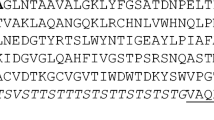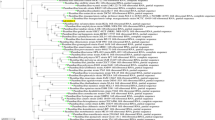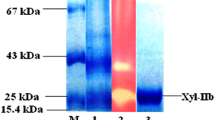Abstract
We cloned and sequenced a xylanase gene named xylD from the acidophilic fungus Bispora sp. MEY-1 and expressed the gene in Pichia pastoris. The 1,422-bp full-length complementary DNA fragment encoded a 457-amino acid xylanase with a calculated molecular mass of 49.8 kDa. The mature protein of XYLD showed high sequence similarity to both glycosyl hydrolase (GH) families 5 and 30 but was more homologous to members of GH 30 based on phylogenetic analysis. XYLD shared the highest identity (49.9%) with a putative endo-1,6-β-d-glucanase from Talaromyces stipitatus and exhibited 21.1% identity and 34.3% similarity to the well-characterized GH family 5 xylanase from Erwinia chrysanthemi. Purified recombinant XYLD showed maximal activity at pH 3.0 and 60 °C, maintained more than 60% of maximal activity when assayed at pH 1.5–4.0, and had good thermal stability at 60 °C and remained stable at pH 1.0–6.0. The enzyme activity was enhanced in the presence of Ni2+ and β-mercaptoethanol and inhibited by some metal irons (Hg2+, Cu2+, Pb2+, Mn2+, Li+, and Fe3+) and sodium dodecyl sulfate. The specific activity of XYLD for beechwood xylan, birchwood xylan, 4-O-methyl-d-glucuronoxylan, and oat spelt xylan was 2,463, 2,144, 2,020, and 1,429 U mg−1, respectively. The apparent K m and V max values for beechwood xylan were 5.6 mg ml−1 and 3,622 μmol min−1 mg−1, respectively. The hydrolysis products of different xylans were mainly xylose and xylobiose.





Similar content being viewed by others
References
Ahmed S, Riaz S, Jamil A (2009) Molecular cloning of fungal xylanases: an overview. Appl Microbiol Biotechnol 84:19–35
Altschul SF, Lipman DJ (1990) Protein database searches for multiple alignments. Proc Natl Acad Sci 87:5509–5513
Altschul SF, Gish W, Miller W, Myers EW, Lipman DJ (1990) Basic local alignment search tool. J Mol Biol 215:403–410
Altschul SF, Madden T, Schaffer A, Zhang J, Zhang Z, Miller W, Lipman D (1997) Gapped BLAST and PSI-BLAST: a new generation of protein database search programs. Nucleic Acids Res 25:3389–3402
Beg QK, Kapoor M, Mahajan L, Hoondal GS (2001) Microbial xylanases and their industrial applications: a review. Appl Microbiol Biotechnol 56:326–338
Beliën T, Joye IJ, Delcour JA, Courtin CM (2009) Computational design-based molecular engineering of the glycosyl hydrolase family 11 B. subtilis XynA endoxylanase improves its acid stability. Protein Eng Des Sel 22:587–596
Biely P (1985) Microbial xylanolytic systems. Trends Biotechnol 3:286–290
Biely P, Vrsanska M, Tenkanen M, Kluepfel D (1997) Endo-beta-1, 4-xylanase families: differences in catalytic properties. J Biotechnol 57:151–166
Chàvez R, Bull P, Eyzaguirre J (2006) The xylanolytic enzyme system from the genus Penicillium. J Biotechnol 23:413–433
Collins T, Gerday C, Feller G (2005) Xylanases, xylanases families and extremophilic xylanases. FEMS Microbiol Rev 29:3–23
Dayhoff MO, Schwartz RM, Orcutt BC (1978) A model of evolutionary change in proteins. In: Dayhoff MO (ed) Atlas of protein sequence and structure, vol. 5, suppl. 3. National Biomedical Research Foundation, Washington, pp 345–352
de Lemos Esteves F, Ruelle V, Lamotte-Brasseur J, Quinting B, Frère JM (2004) Acidophilic adaptation of family 11 endo-β-1, 4-xylanases: modeling and mutational analysis. Protein Sci 13:1209–1218
Fushinobu S, Ito K, Konno M, Wakagi T, Matsuzawa H (1998) Crystallographic and mutational analyses of an extremely acidophilic and acid-stable xylanase: biased distribution of acidic residues and importance of Asp37 for catalysis at low pH. Protein Eng 11:1121–1128
Haegeman A, Vanholme B, Gheysen G (2009) Characterization of a putative endoxylanase in the migratory plant-parasitic nematode Radopholus similes. Mol Plant Pathol 10:389–401
Hurlbert JF, Preston JF III (2001) Functional characterization of a novel xylanase from a corn strain of Erwinia chrysanthemi. J Bacteriol 183:2093–2100
Keen NT, Boyd C, Henrissat B (1996) Cloning and characterization of a xylanase gene from corn strains of Erwinia chrysanthemi. Mol Plant Microb Interact 9:651–657
Khandeparker R, Numan MT (2008) Bifunctional xylanases and their potential use in biotechnology. J Ind Microbiol Biotech 35:635–644
Laemmli UK (1970) Cleavage of structural proteins during the assembly of the head of bacteriophage T4. Nature 227:680–685
Li N, Meng K, Wang YR, Shi PJ, Luo HY, Bai YG, Yang PL, Yao B (2008) Cloning, expression, and characterization of a new xylanase with broad temperature adaptability from Streptomyces sp. S9. Appl Microbiol Biotechnol 80:231–240
Liu YG, Whittier RF (1995) Thermal asymmetric interlaced PCR: automatable amplification and sequencing of insert end fragments from P1 and YAC clones for chromosome walking. Genomics 25:674–681
Luo H, Yang J, Yang P, Li J, Huang H, Shi P, Bai Y, Wang Y, Fan Y, Yao B (2009a) Gene cloning and expression of a new acidic family 7 endo-beta-1, 3–1, 4-glucanase from the acidophilic fungus Bispora sp. MEY-1. Appl Microbiol Biotechnol. doi:10.1007/s00253-009-2119-0
Luo H, Wang Y, Wang H, Yang J, Yang Y, Huang H, Yang P, Bai Y, Shi P, Fan Y, Yao B (2009b) A novel highly acidic β-mannanase from the acidophilic fungus Bispora sp. MEY-1: gene cloning and overexpression in Pichia pastoris. Appl Microbiol Biotechnol 82:453–461
Luo H, Wang Y, Li J, Wang H, Yang J, Yang Y, Huang HQ, Fan YL, Yao B (2009c) Cloning, expression and characterization of a novel acidic xylanase, XYL11B, from the acidophilic fungus Bispora sp. MEY-1. Enzyme Microb Technol 45:126–133
Luo H, Li J, Yang J, Wang H, Yang Y, Huang H, Shi P, Yuan T, Fan Y, Yao B (2009d) A thermophilic and acid stable family-10 xylanase from the acidophilic fungus Bispora sp. MEY-1. Extremophiles 13:849–857
Miller GL (1959) Use of dinitrosalicylic acid reagent for determination of reducing sugar. Anal Chem 31:426–428
Mitreva-Dautova M, Roze E, Overmars H, de Graaff L, Schots A, Helder J, Goverse A, Bakker J, Smant G (2006) A symbiont-independent endo-1, 4-beta-xylanase from the plant-parasitic nematode Meloidogyne incognita. Mol Plant Microb Interact 19:521–529
Nicholas KB, Nicholas Jr HB (1997) GeneDoc: a tool for editing and annotating multiple sequence alignments. (Distributed by the author. http://www.psc.edu/biomed/genedoc)
Polizeli MLTM, Rizzatti ACS, Monti R, Terenzi HF, Jorge JA, Amorim DS (2005) Xylanases from fungi: properties and industrial applications. Appl Microbiol Biotechnol 67:577–591
Sørensen HR, Pedersen S, Jørgensen CT, Meyer AS (2007) Enzymatic hydrolysis of wheat arabinoxylan by a recombinant “minimal” enzyme cocktail containing β-xylosidase and novel endo-1, 4-β-xylanase and α-l-arabinofuranosidase activities. Biotechnol Prog 23:100–107
St John FJ, Rice JD, Preston JF (2006) Characterization of XynC from Bacillus subtilis subsp. subtilis strain 168 and analysis of its role in depolymerization of glucuronoxylan. J Bacteriol 188:8617–8626
Subramaniyan S, Prema P (2002) Biotechnology of microbial xylanases: enzymology, molecular biology, and application. Crit Rev Biotechnol 22:33–64
Suzuki T, Ibata K, Hatsu M, Takamizawa K, Kawai K (1997) Cloning and expression of a 58-kDa xylanase VI gene (xynD) of Aeromonas caviae ME-1 in Escherichia coli which is not categorized as a family F or family G xylanase. J Ferment Bioeng 84:86–89
Tamura K, Dudley J, Nei M, Kumar S (2007) MEGA4: molecular evolutionary genetics analysis (MEGA) software version 4.0. Mol Biol Evol 24:1596–1599
Vršanská M, Kolenová K, Puchart V, Biely P (2007) Mode of action of glycoside hydrolase family 5 glucuronoxylan xylanohydrolase from Erwinia chrysanthemi. FEBS J 274:1666–1677
Wang H, Luo H, Bai Y, Wang Y, Yang P, Shi P, Zhang W, Fan Y, Yao B (2009) An acidophilic beta-galactosidase from Bispora sp. MEY-1 with high lactose hydrolytic activity under simulated gastric conditions. J Agric Food Chem 57:5535–5541
Wong KKY, Tan LUL, Saddler JN (1988) Multiplicity of β-1,4-xylanase in microorganisms: functions and applications. Microbiol Rev 52:305–317
Xue Y, Peng J, Wang R, Song X (2009) Construction of the trifunctional enzyme associating the Thermoanaerobacter ethanolicus xylosidase-arabinosidase with the Thermomyces lanuginosus xylanase for degradation of arabinoxylan. Enzyme Microb Technol 45:22–27
Acknowledgements
This work was supported by the National High Technology Research and Development Program of China (863 program, Grant No. 2007AA100601), Key Program of Transgenic Plant Breeding (2008ZX08003-002), and the Earmarked Fund for Modern Agro-industry Technology Research System (nycytx-42-G2-05). We thank Dr. Kenji Fukuda of Obihiro University of Agriculture and Veterinary Medicine, Japan, for his generosity to provide substrate pustulan.
Author information
Authors and Affiliations
Corresponding author
Additional information
Huiying Luo and Jun Yang contributed equally to this work.
Rights and permissions
About this article
Cite this article
Luo, H., Yang, J., Li, J. et al. Molecular cloning and characterization of the novel acidic xylanase XYLD from Bispora sp. MEY-1 that is homologous to family 30 glycosyl hydrolases. Appl Microbiol Biotechnol 86, 1829–1839 (2010). https://doi.org/10.1007/s00253-009-2410-0
Received:
Revised:
Accepted:
Published:
Issue Date:
DOI: https://doi.org/10.1007/s00253-009-2410-0




